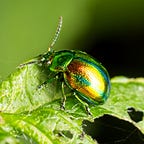Photographing Insects: September Shots
The stories behind some of my insect shots in September
September brought nice weather, so there was ample opportunity to photograph insects. Here are again some of the stories behind the shots I took.
Moving north
New insects are regularly appearing in the Netherlands. They move in from the south, most likely because it gets warmer due to climate change. This plant bug is such an insect. Originally it is from the Canary Islands and Morocco. The first sighting in the Netherlands was in 2018 in the south. The number of sightings is now increasing and from different places in the Netherlands. But it is still rare, so I was happy to find it and take a photo.
Spiders everywhere
In September you see many spiders in the Netherlands. Of course they are not really insects, but I like to shoot them anyway. Many people are afraid of spiders, but when you look up close, many of them are very beautiful. There are very tiny ones, and pretty big ones. (Although in the Netherlands we do not have the huge spiders that exist in some other countries.) Photographing them though is not easy. I normally prefer to have the (up to eight) eyes of the spider visible. But that is almost impossible when they sit on a web, because they normally point their head downwards. Often they also show the wrong side, and they run away when they spot you. I will write a separate article about photographing spiders in the future.
Delicate
After joining a night moth counting event I decided to try this for myself. I bought a very cheap second hand facial tanner. (This produces UV light that attracts the moths.) I hung a white bed sheet in my garden, directed the light towards it, and waited. It was not a good night for moths, but I did see five new species, which was good for a first time. One was this Delicate. Yes, Delicate is the name of a night moth. It is rare in the Netherlands, so that made me very happy. Spotting night moths is really addictive. There are over 2,000 moth species in the Netherlands, so there are so many new insects to discover. See my article on Night Moths for more information.
Hopping planthopper
I had found this, rather common, planthopper when shaking one of my plants, using the pizza box method. The insect had landed on a tray which I then put on the table. I was doing real close-up shots using both my macro lens and my Raynox DCR-250 close-up lens. I put the front bottom of the lens on the tray and slid slowly towards the insect to get the eyes sharp. When the shot was taken, I lifted my head up from the camera. At that very moment the planthopper jumped straight into my face. They can hop really fast I found out. The surprise made me almost drop my camera.
Giving birth
This is not a very good shot, and I would normally not publish it. But the topic is so interesting. There are few insects that give live birth to their children (nymphs). This picture shows that process, with one nymph already born and the next one on its way. What is even more special is that the mother has her wings, which is normally not the case when giving birth. The shot was extra special for me because I took this the day after my grandson was born.
I hope October will again bring some interesting shots, although the number of insects will rapidly decrease. Winter is coming.
Next: Intimate Moments
Previous: Adding a Close-Up Lens
Mark Overmars is a dedicated insect photographer that loves to share and regularly publishes about his work and about photography in general. You can visit his website at www.insectphotography.org. Download his free insect photography book at www.insectphotography.org/book.
